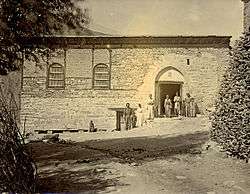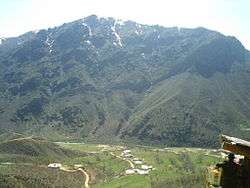Hakkari
Hakkari (Syriac: ܚܟܐܪܝ Ḥakkāri, or ܗܟܐܪܝ Hakkāri, Kurdish: Colemêrg), was a historical mountainous region lying to the south of Lake Van,[1] encompassing parts of the modern provinces of Hakkâri, Şırnak, Van in Turkey and Dohuk in Iraq. During the late Ottoman Empire it was a sanjak within the old Vilayet of Van.

History

The region stretching from Tur Abdin to Hakkari formed the Nairi lands which served as the northern Assyrian frontier and border with their Urartian rivals. The Assyrians of this region were Christians adhering to the Assyrian Church of the East and lived here until 1924, when the very last Assyrians who survived the Assyrian Genocide and massacres that occurred during 1918 were expelled. Most subsequently moved to the Sapna and Nahla valleys in northern Iraq. Those who went to Simele ended up immigrating further to the Tell Tamer Subdistrict in Syria during the 1930s.
Following the devastation of the urban centres of Mesopotamia at the hands of Timur, a Turkic military leader operating under the guise of restoring the Mongol Empire, he was known as "the Sword of Islam." His conquest of Baghdad and the general area, especially the destruction of Tikrit, affected the Syrian Orthodox Church which sheltered near Nineveh at Mar Mattai Monastery following the destruction of Christians in the region, the Ismailis and Sunni and Shi'a Muslims indiscriminately by Timur during the second part of the 14th century. The few survivors sought refuge among the Assyrians of Hakkari and the surrounding region. This region also produced many bishops and patriarchs as hereditary succession was used to prevent a full ecclesiastical collapse of the church. By the 16th century, the Assyrians disappeared from many cities where they previously thrived, such as in Tabriz and Nisibis. The head of the Church of the East moved from Baghdad to Maragha in Urmia by 1553.[2]
By the 1500s, the Assyrians were concentrated in an older version of the Assyrian triangle, with its points in Diyarbakir(west), Maragha(east). The Church of the East lost some of its members in the few centuries following the Schism of 1552 to the Chaldean Catholic Church, mainly in Diyarbakir. Those living in Hakkari, however, were unaffected by the disputes until 1692 when the Chaldean Archbishop of Diyarbakir Shimun IX Dinkha broke away from Rome and moved to Qudshanis in Hakkari where he reintroduced the Shimun line of hereditary patriarchial succession which continued until 1976.
The Patriarch residing in the Church of Mār Shalīṭa in Qudshanis enjoyed both spiritual and political power over his subjects. Since priests were required to remain celibates the patriarchy moved from uncle to nephew.[2] This system came to be known as Nāṭar Kursyā (ܢܛܪ ܟܘܪܣܝܐ "Guardian of the throne"), and by the 19th century this system was applied to all dioceses of Hakkari.[3] The Assyrians formed intricate alliances with neighbouring Kurdish tribes and their Ottoman lords, and each tribe was led by a Malik (ܡܠܟ) who also functioned as a military leader during wartime.[4]
Kurdish wars
In the 19th century, several competing Kurdish centers began emerging in the region. Mir Muhammed, the Kurdish Emir of the Soran Emirate, situated around Rawanduz was able to depose his rivals and control a region stretching from Mardin to Persian Azerbaijan.[5] He was however defeated in battle when he tried to subdue the Assyrians of Hakkari in 1838. The Ottomans, seeking to consolidate their control of the region, engaged him in a costly war which eventually led to the dissolution of his Emirate.[6]
After the fall of his main rival, Bedir Khan of Bohtan, Badr Khan sought to extend his dominion by annexing the Assyrian regions in Hakkari.[7] He took advantage of a rift between the patriarch Shimun XVII Abraham and Nur Allah, the Emir of Hakkari. Badr Khan allied with Nur Allah and attacked the Assyrians of Hakkari in the summer of 1843 massacring them and taking those who survived as slaves.[8] Another massacre was inflicted in 1846 on the Assyrians of Tiyari, also residing in Hakkari.[8] The western powers, alarmed by the massacres pressured the Ottomans to intervene. Badr Khan was subsequently defeated and exiled to Crete in 1847.[8]
Direct Ottoman control

Although the region was nominally under Ottoman control since the 16th century, it was in reality administered by its Assyrian and Kurdish inhabitants and their lords. The situation changed after the Badr Khans rule and the Tanzimat reforms as the Ottomans now were able to extend their full control unopposed, and in 1868 the Sanjak of Hakkari was created.[9]
Genocide and exodus
On the eve of the First World War, patriarch Shimun XIX Benyamin was promised preferential treatment in anticipation of the war.[10] Shortly after the war began, however, Assyrian and Armenian settlements to the north of Hakkari were attacked and sacked by Kurdish irregulars allied with the Ottoman Army in the Assyrian Genocide.[11][12] Others were forced into labour battalions and later executed.[13]
The turning point was when the patriarch's brother was taken prisoner as he was studying in Constantinople. The Ottomans demanded Assyrian neutrality and executed him as a warning.[14][15] In return, the patriarch declared war on the Ottomans on 10 April 1915.[14]
The Assyrians were immediately attacked by Kurdish irregulars backed by the Ottomans, driving most of the Assyrians of Hakkari to the mountain tops, as those who stayed in their villages were killed.[14] Shimun Benjamin was able to move unnoticed to Urmia, which at the time was under Russian control, and tried to persuade them to send a relief force to the besieged Assyrians.[14] When the Russians replied that the request was unreasonable, he returned to Hakkari and led the surviving 50,000 Assyrians through the mountains to safety in Urmia.[14] Thousands perished from cold and hunger during this march.[14]
After the First World War
During the peace conferences in Paris in 1919, the Assyrians asked for a state in Diyarbekir and northern Mesopotamia in Iraq; others requested a British protectorate in Upper Mesopotamia, northern Mosul, and Urmia.[16] The Assyrians tried to retake the region, but the Turks and Kurds objected to the Nestorian Christians desire to retake their ancestral lands in Hakkari, and an attempt to occupy the region by Agha Petros failed. In 1924 Turkey formally occupied northern Hakkari and expelled the last Christian inhabitants who still remained in the region,[17] with the exception of the village of Gaznakh which due to Kurdish alliances and their conversion to the Chaldean Catholic Church avoided deportation. Assyrians still live in the southern Hakkari region of Barwari Bala, now straddling fhe Turkey-Iraq border, and in the Sapna and Nahla Valleys of Iraqs Nohadra region.
Economy
As of 1920, Hakkari was producing lead. The lead, which came from a government owned mine, was used to make bullets.[18]
See also
| Wikimedia Commons has media related to Hakkari. |
- List of Assyrian tribes
- Tyari
- Barwari
- Shemsdin (East Syrian Ecclesiastical Province)
- Assyrian homeland
Notes
- Aboona 2008, p. 2
- Alexander 1994, p. 36
- Wilmshurst 2000, p. 277
- Aboona 2008, p. 35
- Aboona 2008, p. 173
- Aboona 2008, p. 174
- Aboona 2008, p. 179
- McDowall 2000, p. 47
- Aboona 2008, p. 3
- Stafford 2006, p. 23
- Stafford 2006, p. 24
- Gaunt & Beṯ-Şawoce 2006, p. 134
- Gaunt & Beṯ-Şawoce 2006, p. 136
- Stafford 2006, p. 25
- Yusuf, Malik. "The Assyrian Tragedy". www.aina.org. Retrieved May 20, 2020.
- Nisan 2002, p. 187
- Nisan 2002, p. 188
- Prothero, W. G. (1920). Armenia and Kurdistan. London: H.M. Stationery Office. p. 71.
References
- Nisan, M (2002) [1991], Minorities in the Middle East: a history of struggle and self-expression, McFarland, ISBN 978-0-7864-1375-1.
- Alexander, V (1994) [1994], The First Civilization, Victor Alexander, ISBN 978-1-4486-7089-5.
- Stafford, R (2006) [1935], The Tragedy of the Assyrians, Gorgias Press, ISBN 978-1-59333-413-0.
- Aboona, H (2008), Assyrians, Kurds, and Ottomans: intercommunal relations on the periphery of the Ottoman Empire, Cambria Press, ISBN 978-1-60497-583-3.
- Wilmshurst, D (2000), The ecclesiastical organisation of the Church of the East, 1318-1913, Volume 582, Cambria Press, ISBN 978-90-429-0876-5.
- McDowall, D (2000), A modern history of the Kurds, I.B. Tauris, ISBN 978-1-85043-416-0.
- Gaunt, D; Beṯ-Şawoce, J (2006), Massacres, resistance, protectors: Muslim-Christian relations in Eastern Anatolia during World War I, Gorgias Press, ISBN 978-1-59333-301-0.